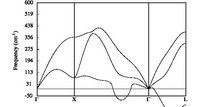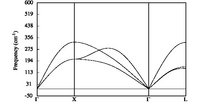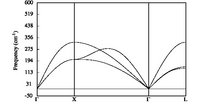From a long time now, I am trying to get nice phonon dispersion curves for simple metals in the simple FCC structure (primitive cell, rhomboedral structure).
Using the tutorial provided on the abinit website, and using the provided Al pseudopotential (13al.981214.fhi), I can obtain the wanted phonon dispersion curve.
The problem occurs when using LDA PAW atomic data. I just cannot obtain a correct dispersion curves. Whatever I do, it is just no correct. I tried to increase accuracy and it makes no changes. I also tried different Self-Consistent-Field cycles and it makes no difference. With abinit 7.0.3, one can now test the pawxcdev parameter, and again, no more improvements. I though that it could come from the PAW I used, even if tests were ok, so I made test with other elements (Au) and the results are even worst.
Actually, I do not know what to do more. All aids and suggestions are welcome. thanks,
Emile
Typical RF input file:
Code: Select all
# Crystalline Al : computation of the phonon spectrum
ndtset 9
#Set 1 : ground state self-consistency
getwfk1 0 # Cancel default
kptopt1 1 # Automatic generation of k points, taking
# into account the symmetry
nqpt1 0 # Cancel default
tolvrs1 1.0d-20 # SCF stopping criterion (modify default)
rfphon1 0 # Cancel default
#Q vectors for all datasets
#Complete set of symmetry-inequivalent qpt chosen to be commensurate
# with kpt mesh so that only one set of GS wave functions is needed.
#Generated automatically by running GS calculation with kptopt=1,
# nshift=0, shiftk=0 0 0 (to include gamma) and taking output kpt set
# file as qpt set. Set nstep=1 so only one iteration runs.
nqpt 1 # One qpt for each dataset (only 0 or 1 allowed)
# This is the default for all datasets and must
# be explicitly turned off for dataset 1.
qpt2 0.00000000E+00 0.00000000E+00 0.00000000E+00
qpt3 2.50000000E-01 0.00000000E+00 0.00000000E+00
qpt4 5.00000000E-01 0.00000000E+00 0.00000000E+00
qpt5 2.50000000E-01 2.50000000E-01 0.00000000E+00
qpt6 5.00000000E-01 2.50000000E-01 0.00000000E+00
qpt7 -2.50000000E-01 2.50000000E-01 0.00000000E+00
qpt8 5.00000000E-01 5.00000000E-01 0.00000000E+00
qpt9 -2.50000000E-01 5.00000000E-01 2.50000000E-01
#Sets 4-10 : Finite-wave-vector phonon calculations (defaults for all datasets)
getwfk 1 # Use GS wave functions from dataset1
kptopt 3 # Need full k-point set for finite-Q response
rfphon 1 # Do phonon response
rfatpol 1 1 # Treat displacements of all atoms
rfdir 1 1 1 # Do all directions (symmetry will be used)
tolvrs 1.0d-10 # This default is active for sets 3-10
#######################################################################
#Common input variables
#Definition of the unit cell
acell 3*7.5204497364 # This is equivalent to 10.61 10.61 10.61
rprim 0.0 0.5 0.5 # In lessons 1 and 2, these primitive vectors
0.5 0.0 0.5 # (to be scaled by acell) were 1 0 0 0 1 0 0 0 1
0.5 0.5 0.0 # that is, the default.
#Definition of the atom types
ntypat 1 # There are two types of atom
znucl 13 # The keyword "znucl" refers to the atomic number of the
# possible type(s) of atom. The pseudopotential(s)
# mentioned in the "files" file must correspond
# to the type(s) of atom. Here, type 1 is the Aluminum,
# type 2 is the Arsenic.
#Definition of the atoms
natom 1 # There are two atoms
typat 1 # The first is of type 1 (Al), the second is of type 2 (As).
xred 0.0 0.0 0.0
#Gives the number of band, explicitely (do not take the default)
nband 40
occopt 3
tsmear 300.00 K
#Definition of the planewave basis set
ecut 40.0 # Maximal kinetic energy cut-off, in Hartree
pawecutdg 120.0
pawxcdev 0
#Definition of the k-point grid
ngkpt 4 4 4
nshiftk 4 # Use one copy of grid only (default)
shiftk 0.0 0.0 0.5 # This gives the usual fcc Monkhorst-Pack grid
0.0 0.5 0.0
0.5 0.0 0.0
0.5 0.5 0.5
#Definition of the SCF procedure
iscf 7 # Self-consistent calculation, using algorithm 5
nstep 2000 # Maximal number of SCF cycles
diemac 9.0 # Although this is not mandatory, it is worth to
# precondition the SCF cycle. The model dielectric
# function used as the standard preconditioner
# is described in the "dielng" input variable section.
# The dielectric constant of AlAs is smaller that the one of Si (=12).
# add to conserve old < 6.7.2 behavior for calculating forces at each SCF step
optforces 1
typical anaddb input file:
Code: Select all
!Input file for the anaddb code. Analysis of the SiO2 DDB
!Flags
ifcflag 1 ! Interatomic force constant flag
!Wavevector grid number 1 (coarse grid, from DDB)
brav 2 ! Bravais Lattice : 1-S.C., 2-F.C., 3-B.C., 4-Hex.)
ngqpt 4 4 4 ! Monkhorst-Pack indices
nqshft 1 ! number of q-points in repeated basic q-cell
q1shft 3*0.0
!Effective charges
asr 1 ! Acoustic Sum Rule. 1 => imposed asymetrically
chneut 1 ! Charge neutrality requirement for effective charges.
!Interatomic force constant info
dipdip 1 ! Dipole-dipole interaction treatment
!Phonon band structure output for band2eps - See note near end for
! dealing with gamma LO-TO splitting issue.
eivec 4
!Wavevector list number 1 (Reduced coordinates and normalization factor)
nph1l 81 ! number of phonons in list 1
qph1l 0.00000000E+00 0.00000000E+00 0.00000000E+00 1.000 !gamma
2.50000000E-02 2.50000000E-02 0.00000000E+00 1.000
5.00000000E-02 5.00000000E-02 0.00000000E+00 1.000
7.50000000E-02 7.50000000E-02 0.00000000E+00 1.000
1.00000000E-01 1.00000000E-01 0.00000000E+00 1.000
1.25000000E-01 1.25000000E-01 0.00000000E+00 1.000
1.50000000E-01 1.50000000E-01 0.00000000E+00 1.000
1.75000000E-01 1.75000000E-01 0.00000000E+00 1.000
2.00000000E-01 2.00000000E-01 0.00000000E+00 1.000
2.25000000E-01 2.25000000E-01 0.00000000E+00 1.000
2.50000000E-01 2.50000000E-01 0.00000000E+00 1.000
2.75000000E-01 2.75000000E-01 0.00000000E+00 1.000
3.00000000E-01 3.00000000E-01 0.00000000E+00 1.000
3.25000000E-01 3.25000000E-01 0.00000000E+00 1.000
3.50000000E-01 3.50000000E-01 0.00000000E+00 1.000
3.75000000E-01 3.75000000E-01 0.00000000E+00 1.000
4.00000000E-01 4.00000000E-01 0.00000000E+00 1.000
4.25000000E-01 4.25000000E-01 0.00000000E+00 1.000
4.50000000E-01 4.50000000E-01 0.00000000E+00 1.000
4.75000000E-01 4.75000000E-01 0.00000000E+00 1.000
5.00000000E-01 5.00000000E-01 0.00000000E+00 1.000 !X
4.87500000E-01 4.87500000E-01 0.97500000E+00 1.000
4.75000000E-01 4.75000000E-01 0.95000000E+00 1.000
4.62500000E-01 4.62500000E-01 0.92500000E+00 1.000
4.50000000E-01 4.50000000E-01 0.90000000E+00 1.000
4.37500000E-01 4.37500000E-01 0.87500000E+00 1.000
4.25000000E-01 4.25000000E-01 0.85000000E+00 1.000
4.12500000E-01 4.12500000E-01 0.82500000E+00 1.000
4.00000000E-01 4.00000000E-01 0.80000000E+00 1.000
3.87500000E-01 3.87500000E-01 0.77500000E+00 1.000
3.75000000E-01 3.75000000E-01 0.75000000E+00 1.000
3.62500000E-01 3.62500000E-01 0.72500000E+00 1.000
3.50000000E-01 3.50000000E-01 0.70000000E+00 1.000
3.37500000E-01 3.37500000E-01 0.67500000E+00 1.000
3.25000000E-01 3.25000000E-01 0.65000000E+00 1.000
3.12500000E-01 3.12500000E-01 0.62500000E+00 1.000
3.00000000E-01 3.00000000E-01 0.60000000E+00 1.000
2.87500000E-01 2.87500000E-01 0.57500000E+00 1.000
2.75000000E-01 2.75000000E-01 0.55000000E+00 1.000
2.62500000E-01 2.62500000E-01 0.52500000E+00 1.000
2.50000000E-01 2.50000000E-01 0.50000000E+00 1.000
2.37500000E-01 2.37500000E-01 0.47500000E+00 1.000
2.25000000E-01 2.25000000E-01 0.45000000E+00 1.000
2.12500000E-01 2.12500000E-01 0.42500000E+00 1.000
2.00000000E-01 2.00000000E-01 0.40000000E+00 1.000
1.87500000E-01 1.87500000E-01 0.37500000E+00 1.000
1.75000000E-01 1.75000000E-01 0.35000000E+00 1.000
1.62500000E-01 1.62500000E-01 0.32500000E+00 1.000
1.50000000E-01 1.50000000E-01 0.30000000E+00 1.000
1.37500000E-01 1.37500000E-01 0.27500000E+00 1.000
1.25000000E-01 1.25000000E-01 0.25000000E+00 1.000
1.12500000E-01 1.12500000E-01 0.22500000E+00 1.000
1.00000000E-01 1.00000000E-01 0.20000000E+00 1.000
8.75000000E-02 8.75000000E-02 0.17500000E+00 1.000
7.50000000E-02 7.50000000E-02 0.15000000E+00 1.000
6.25000000E-02 6.25000000E-02 0.12500000E+00 1.000
5.00000000E-02 5.00000000E-02 0.10000000E+00 1.000
3.75000000E-02 3.75000000E-02 0.07500000E+00 1.000
2.50000000E-02 2.50000000E-02 0.05000000E+00 1.000
1.25000000E-02 1.25000000E-02 0.02500000E+00 1.000
0.00000000E+00 0.00000000E+00 0.00000000E+00 1.000 !gamma
2.50000000E-02 2.50000000E-02 2.50000000E-02 1.000
5.00000000E-02 5.00000000E-02 5.00000000E-02 1.000
7.50000000E-02 7.50000000E-02 7.50000000E-02 1.000
1.00000000E-01 1.00000000E-01 1.00000000E-01 1.000
1.25000000E-01 1.25000000E-01 1.25000000E-01 1.000
1.50000000E-01 1.50000000E-01 1.50000000E-01 1.000
1.75000000E-01 1.75000000E-01 1.75000000E-01 1.000
2.00000000E-01 2.00000000E-01 2.00000000E-01 1.000
2.25000000E-01 2.25000000E-01 2.25000000E-01 1.000
2.50000000E-01 2.50000000E-01 2.50000000E-01 1.000
2.75000000E-01 2.75000000E-01 2.75000000E-01 1.000
3.00000000E-01 3.00000000E-01 3.00000000E-01 1.000
3.25000000E-01 3.25000000E-01 3.25000000E-01 1.000
3.50000000E-01 3.50000000E-01 3.50000000E-01 1.000
3.75000000E-01 3.75000000E-01 3.75000000E-01 1.000
4.00000000E-01 4.00000000E-01 4.00000000E-01 1.000
4.25000000E-01 4.25000000E-01 4.25000000E-01 1.000
4.50000000E-01 4.50000000E-01 4.50000000E-01 1.000
4.75000000E-01 4.75000000E-01 4.75000000E-01 1.000
5.00000000E-01 5.00000000E-01 5.00000000E-01 1.000 !L
!Wavevector list number 2 (Cartesian directions for non-analytic gamma phonons)
!The output for this calculation must be cut-and-pasted into the
! t59_out.freq file to be used as band2eps input to get proper LO-TO
! splitting at gamma. Note that gamma occurrs twice.
nph2l 1 ! number of directions in list 2
qph2l 1.0 0.0 0.0 0.0
# This line added when defaults were changed (v5.3) to keep the previous, old behaviour
symdynmat 0




